Mark Gresham | 21 NOV 2020
Thursday evening’s video concert the Atlanta Symphony Orchestra featured a couple of important firsts: the classical subscription series debut of new ASO associate conductor Jerry Hou and contrabassist Xavier Dubois Foley in his ASO classical subscription debut as both guest soloist and composer. In addition to a work by Foley, the concert featured music by Franz Schubert and Giovanni Bottesini. Most interesting is that unlike most guest artists who typically perform as a soloist in just one work, Foley played in all of the evening’s musical selections. The concert video remains available online to virtual season ticket holders through Sunday evening at 8pm at atlantasymphony.org
The program opened with a familiar, well-love chamber work: Schubert’s Piano Quintet in A Major, Op.114 (“The Trout”) in which Foley, as double bassist, was joined by pianist Julie Coucheron and three principal strings from the ASO, concertmaster David Coucheron, principal violist Zhenwei Shi and principal cellist Rainer Eudeikis. The latter four had performed together just last Sunday. Nov. 15, in a Georgian Chamber Players concert, although by that time this ASO concert had already been recorded, according to the video in session from Nov. 11 – 13. The advance recording dates are necessary to allow sufficient editing time for each Thursday’s scheduled streamed broadcast, with next week’s concert scheduled for a Saturday streaming date instead because of Thanksgiving Day. These five musicians gave the 40-minute “Trout” a vibrant, joyfully extroverted performance.

Schubert’s “Trout Quintet” (l-r): David Coucheron, Julie Coucheron, Zhenwei Shi, Xavier Foley, Rainer Eudeikis (ASO video frame capture)
Foley, a 26-year-old native of Marietta, Georgia, began his music studies at age 8 on piano, but soon switched to playing contrabass (aka “double bass”), and because there was not much solo repertoire specifically for the instrument, he began composing and arranging music for the instrument himself.
For Justice and Peace, which Foley says in an interview in then video, was “based off the 400th anniversary of first-time slaves arriving in Jamestown, Virginia.” But he also, whenever he gets a commission, makes sure he is allowed to write for and feature the bass.
Foley became a member of the Atlanta Symphony Youth Orchestra, and his first teacher, the late ASO section bass player Douglas Sommer, introduced him to the ASO’s Talent Development Program, which prepared him for his next goal, to study at the Curtis Institute with the esteemed double bassist Edgar Meyer.
The most fascinating piece of the program was Foley’s own composition, For Justice and Peace, a double concertino co-commissioned by Carnegie Hall, the Sphinx Organization, and the New World Symphony, for violin, contrabass and string orchestra, plus prominent featured use of a judge’s gavel (the only percussion instrument in the piece) and brief but crucial passage for vocal quartet. The influence of Edgar Meyer can easily be heard, but Foley demonstrably has his own fresh and confident compositional voice and skillful style. For Justice and Peace organically develops over its nine-and-a-half minutes, mostly out of a pair of succinct principal motifs. This is totally approachable, compelling music that you won’t regret experiencing and will easily want to hear again.
At eight minutes into the piece, the work reaches a climax with the entry of the quartet of amplified vocalists, drawn from the ASO Chorus (Wanda Yang Temko, Ana Baida, Brent Runnels and Trey Clegg), singing in slow, cathedral-like long tones against the much busier instrumental undercurrent:
Where’s my freedom?
We shall have equality,
With liberty and justice for all.
A few scratching notes from the violin and drumming on the body of contrabass intervene before the vocalists’ rhythmic pace suddenly picks up on the last line, interrupted at its end by another smack of the gavel. The contrabass responds, with pizzicato commentary from the orchestra’s lower strings, followed by yet another bang of the gavel. Then the violin and contrabass do a brief dialogue that is answered in emphatic unison by the full orchestra before a final three, rhythmically deliberate whacks of the gavel come down. But the immediate final say comes with a rapid drummed rhythm on the body of solo contrabass’ body, simultaneously with an affirmative final forte note from the full orchestra.

ASO associate conductor Jerry Hou (source: ASO video fame capture)
The vocal parts work well as a quartet (and surely obligatory due to necessary pandemic restrictions involved) but even though their part is only 45 seconds long, one can easily imagine it sung by a full chorus – a “voice of the people” rather than the pleas of a few. In a post-covid world, that would oblige programming For Justice and Peace with another choral work of similar sentiment. The “Prisoners’ Chorus” from Beethoven’s Fidelio: “Oh what joy, in the open air / Freely to breathe again! / Up here alone is life” and also its admonition, so relevant to our 21st century and its penchant for technological surveillance: “Speak softly! Be on your guard! / We are watched with eye and ear” – and why not, in this context, rearrange the male chorus parts for mixed voices? For Justice and Peace can easily find its way as a double concertino onto a mostly choral concert, shared with a small string orchestra, that fits an overall “justice and peace” theme.
By the start of the final piece, Giovanni Bottesini’s Double Bass Concerto No. 2 in B minor (1845), Foley had already demonstrated well his virtuosity and expressive playing, but the concerto was a fine platform to reinforce that, with its late 19th-century expressive lyricism and display of skill. It’s a piece Foley’s mentor, Edgar Meyer, continues to maintain in his own solo repertoire list. Foley gives the solo performance of this 18-minute concerto a quality which, especially in the first movement’s cadenza and the slow second movement, felt as if it were sung as much as played, though some of the passages of the first are far beyond the capacities of a human voice. Even though in a minor key, then final movement rollicked along an cheerful display of the soloist’s skill and increasing dramatic outbursts by the orchestra as it neared the work’s sudden gear-shift into a somewhat barn-burner coda.

Xavier Foley is soloist for Bottesini’s “Double Bass Concerto No. 2 in B minor” (source: ASO video fame capture)
For his part a conductor, Jerry Hou, in this subscription debut with the ASO, guided the orchestra well in a clear and incisive interaction with the two soloists in For Justice and Peace, and with the addition of winds for the Bottesini he allowed for a little looser accompaniment that suited the concerto’s style. My own preference was for Foley’s work and its strong musical dialogues among all participants in which Hou’s conducting made the best impression. The Bottesini seemed, to my mind, a less significant work than the Foley, however necessarily standard a piece of repertoire for a contrabass soloist.
Otherwise it was not the kind of program that offered a lot of insight into the conductor’s personal musical vision, but served to demonstrate his worth as a capable collaborator with soloists, where a shared and typically secondary vision of the music is required of the individual on the podium. But we’ll get to that point with Hou in due time. As it is, listeners can turn for more to such things as Hou’s YouTube channel, an interview in this video which precedes the concert, and his recent EarRelevant interview with Mark Buller, in learning the musical mind of the ASO’s new associate conductor. ■
RECENT POSTS













.png)